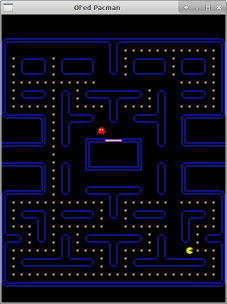Otus Lisp, an extensible embedded language.
#include <ol/ol.h>
int main(int argc, char **argv)
{
ol_t ol;
OL_new(&ol, NULL);
OL_eval(&ol, new_string(&ol, "(print \"hello\")"), 0);
OL_delete(&ol);
}$ gcc file-above.c -lol -o main -O0 -g3
$ ./main
helloThis folder demonstrates a usage of Otus Lisp as part of a pacman-like game.
The A* path searching algorithm and Blinky state completely implemented in Otus Lisp (main.scm file). The OpenGL rendering and keyboard processing implemented in C (main.c file).
Files:
- main.c - main "C" program with opengl, keyboard and win/lose logic.
- main.scm - main "Lisp" program module with level and A* blinky brains.
- Makefile - build script for all three embedding options.
- resources/*.png - game resources (background, sprites, etc.).
- texturing.c - png texture reader.
- embed1.c - embedding option 1, just a way.
- embed2.c - embedding option 2, simpler way with few oddish C-macro.
- embed3.c - embedding option 3, fastest and smallest way with precompiled lisp code (required deeper knowledge of otus lisp language).
- precompile.scm - lisp compiler for option 3.
Temporary files:
- repl.o - Otus Lisp REPL binary (400 KB).
- tmp.bin - precompiled by precompile.scm game lisp binary (64 KB).
- binf.c - tmp.bin, converted into unsigned char* variable (using xxd tool) (400 KB) to be included in embed3.c.
Output files:
- pacman1 - compiled embedding option 1 (consumes about 3 MB of memory).
- pacman2 - compiled embedding option 2 (consumes same as pacman1).
- pacman3 - compiled embedding option 3 (consumes only 200 KB of memory and much more faster than pacman1 and pacman2).
Please read the embed1.c, embed2.c, and embed3.c complete source codes for a better usage understanding.
Just compare all three embedding options usage.
Basic library usage:
// olvm:
ol_t ol;
extern unsigned char REPL[];
void ol_new_ol()
{
OL_new(&ol, REPL);
OL_eval(&ol, new_string(&ol, "(import (main))"), 0);
OL_eval(&ol, new_string(&ol, "(born-blinky)"), 0);
}
...
void ol_get_blinky(int* x, int* y)
{
uintptr_t xy = OL_eval(&ol,
new_string(&ol, "(get-blinky)"),
0);
assert (is_pair(xy));
*x = ol2int(car(xy));
*y = ol2int(cdr(xy));
}
...
void ol_blinky_move(int x, int y)
{
OL_eval(&ol,
new_string(&ol, "blinky-move"),
make_integer(x),
make_integer(y),
0);
}Smart macro, simpler usage:
// olvm:
ol_t ol;
extern unsigned char REPL[];
void ol_new_ol()
{
OL_new(&ol, REPL);
eval("(import (main)) (born-blinky)");
}
...
void ol_get_blinky(int* x, int* y)
{
uintptr_t xy = eval("(get-blinky)");
assert (is_pair(xy));
*x = ol2int(car(xy));
*y = ol2int(cdr(xy));
}
...
void ol_blinky_move(int x, int y)
{
eval("blinky-move", x, y);
}Precompiled ol code, fastest (near native) execution:
// olvm:
struct olvm_t* vm;
int get_blinky;
int blinky_move;
extern unsigned char tmp_bin[];
void ol_new_ol()
{
vm = OLVM_new(tmp_bin);
OLVM_userdata(vm, &vm);
uintptr_t
r = OLVM_run(vm, 0, 0);
// well, we have our "smart" script prepared,
// now save functions for feature use
assert (is_vector(r));
...
get_blinky = ol2int(ref(r, 2));
...
blinky_move = ol2int(ref(r, 6));
...
}
...
void ol_get_blinky(int* x, int* y)
{
uintptr_t xy = OLVM_evaluate(vm,
OLVM_deref(vm, get_blinky),
0, NULL);
assert (is_pair(xy));
*x = ol2int(car(xy));
*y = ol2int(cdr(xy));
}
...
void ol_blinky_move(int x, int y)
{
uintptr_t args[] = {
make_integer(x),
make_integer(y)
};
OLVM_evaluate(vm,
OLVM_deref(vm, blinky_move),
2, args);
}